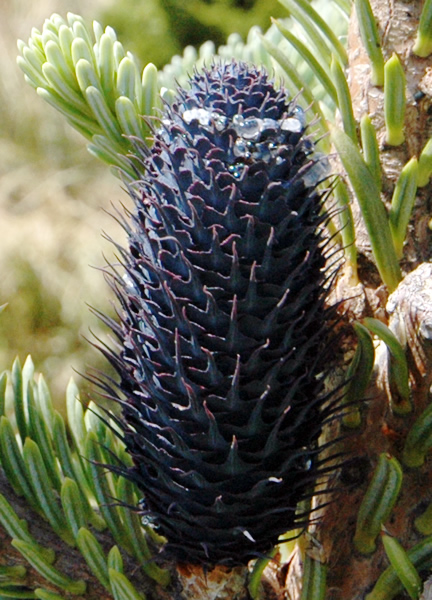
Woody > Abies > Abies squamata > Abies squamata 'Flaky'
Abies squamata
'Flaky'
Flaky Fir
Origin: Native to China.
Mike's
Opinion


"
Abies squamata ‘Flaky’ is very unique and an interesting evergreen tree. With its rich, flaky-like bark and intense purple cones, this rare tree is truly a specimen plant when used in the landscape.
Michael Pascoe, NDP., ODH., CLT., MSc. (Plant Conservation)
"
| Family |
| Pinaceae |
| Genus |
| Abies |
| Species |
| squamata |
| Cultivar |
| 'Flaky' |
| Category |
| Woody |
| Type |
| Tree (evergreen) |
| Pronunciation |
| USDA Hardiness Zone |
| 2 - 8 |
| Canadian Hardiness Zone |
| 0 - 8 |
| RHS Hardiness Zone |
| H7 - H4 |
| Temperature (°C) |
| -46 to -7 |
| Temperature (°F) |
| -50 - 20 |
| Height |
| 30 – 40 m |
| Spread |
| 4 – 5 m |
Photographs
Description and Growing Information
Flowering Period
| General Description |
| Abies squamata 'Flaky’ is a tall, very unique tree largely due to its purple cones and flaky-like bark. |
| Landscape |
| Not primarily used in the landscape due to rarity, but may be used as a lawn ornament. |
| Cultivation |
| Prefers well drained or dry acidic soils and can withstand living in light (sandy) soil, medium (loamy) soil and heavy (clay) soil. This species can tolerate full/some shade and full/some sun, although if subject to full shade when young the tree will grow much slower. It is pollinated by wind. |
| Shape |
| Loose form with an upright growth habit. |
| Growth |
| Slow |
| ID Characteristic |
| Abies squamata ‘Flaky’ has outstanding purple upright cones and flake-like reddish-brown exfoliating bark which make this a unique evergreen tree that can be identified quite easily. |
| Pests |
| No known pest/disease for this particular cultivar. Note the Abies genus is subject to spruce budworm. |
| Habitat |
| Horticultural origin. |
| Bark/Stem Description |
| Rich, brown-reddish, thin, papery, exfoliating bark (similar to birch) which allows for winter interest. |
| Flower/Leaf Bud Description |
| Cones are oblong, ovate to 5 – 6 cm long, violet colour when young. Tips have bract overhanging the seed scales and are 1.5 cm long, globose, red-brown and very resinous. |
| Leaf Description |
| Needles are densely arranged, linear, 1.5 – 2.5 cm long, rounded tip, with 2 white stomata bands on lower part of tree and a distinct vein up the back of the needle. |
| Flower Description |
| Flowers are monecious, individual flowers, male or female; but can find both sexes on a plant; pollinated by wind. |
| Colour Description |
| Needles are dark blue-green with silvery undersides. Cones are violet colour when young and a striking purple colour when mature. |
| Texture Description |
| Leathery, stiff needles. |
| Notable Specimens |
| Whistling Gardens, Wilsonville, Ontario, Canada. |
